

Quantum Mechanics Revisited: Physicists Propose New Structure of Time. The Nature of Time Does time flow continuously, gliding without interruption from one happening to another?

Or is it choppy and pixelated, an illusory phenomenon formed of innumerable discrete elements? The world of our sensory experience would seem to support the former notion—that time moves ever, ever on; however, new research, which was recently published in The European Physical Journal C, suggests time may be much grainier than we suppose, and the idea has important implications for quantum mechanics.
The research centers on what is called the “Planck time,” approximately 10-43 seconds, which is widely believed to be the smallest meaningful unit of time. Defined as the time interval required for light to traverse the Planck length (about 1.6 x 10-35 meter), the Planck time resides at that incomprehensible scale where spacetime, reality, and everything that is begins to break down and lose all meaning. Time After Time Read a little further into the paper, and things get really weird.
Scientists Have Figured Out What We Need to Achieve Secure Quantum Teleportation. Quantum Teleportation An international collaboration of researcher from China, Europe, and Australia have demonstrated the precise requirements needed to secure quantum teleportation, a concept that is essential to the future of a quantum internet that lets information to be transmitted securely.

Of course, quantum teleportation doesn’t mean that it’s possible for a person to instantly pop from New York to London, but they can instantly transport information through a bizarre quantum mechanics property called entanglement. Quantum Surreality: Scientists Observe the Motion of Entangled Photons. Physicists May Have Discovered a New "Tetraquark" Particle. Evidence for a never-before-seen particle containing four types of quark has shown up in data from the Tevatron collider at the Fermi National Accelerator Laboratory (Fermilab) in Illinois.
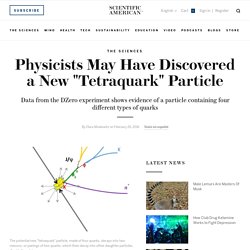
The new particle, a class of “tetraquark,” is made of a bottom quark, a strange quark, an up quark and a down quark. The discovery could help elucidate the complex rules that govern quarks—the tiny fundamental particles that make up the protons and neutrons inside all the atoms in the universe. Protons and neutrons each contain three quarks, which is by far the most stable grouping. Pairs of quarks, called mesons, also commonly appear, but larger conglomerations of quarks are extremely rare. Quantum physics for the terminally confused. Credit: BSIP/Getty Images Does quantum physics melt your brain?
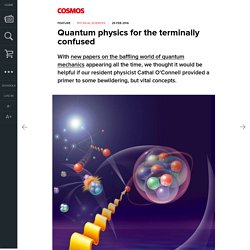
First, don’t panic. You’re not alone in your confuddlement. As legendary physicist Richard Feynman said: “I think I can safely say that nobody understands quantum mechanics.” Nevertheless, quantum theory is vital for describing how our world is screwed together. Researchers discover new fundamental quantum mechanical property. Image (c): NASA/Sonoma State University/Aurore Simonnet A newly-discovered fundamental property of electrical currents in extremely small metal circuits demonstrates how negatively-charged particles can wash over said circuit like waves, generating interference in parts of the circuit where no current is delivered.
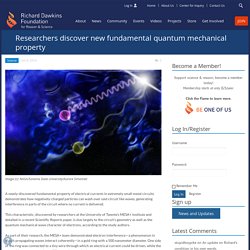
This characteristic, discovered by researchers at the University of Twente’s MESA+ institute and detailed in a recent Scientific Reports paper, is due largely to the circuit’s geometry as well as the quantum mechanical wave character of electrons, according to the study authors. As part of their research, the MESA+ team demonstrated electron interference—a phenomenon in which propagating waves interact coherently—in a gold ring with a 500 nanometer diameter. One side of the ring was connected to a tiny wire through which an electrical current could be driven, while the other side was connected to a different wire attached to a voltmeter. Physicists discover easy way to measure entanglement—on a sphere.
Quantum entanglement—which occurs when two or more particles are correlated in such a way that they can influence each other even across large distances—is not an all-or-nothing phenomenon, but occurs in various degrees.
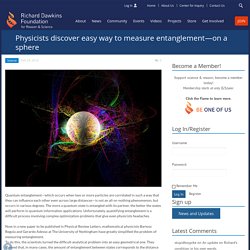
Theory of Everything: Unifying Gravity and Quantum Mechanics. Earth: The Blue Marble Credit: NASA/Goddard Space Flight Center/Reto Stöckli Quantum mechanics may seem like it is beyond our realm of experience; however, it is an integral part of the physics that governs our lives.
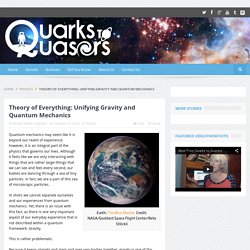
Although it feels like we are only interacting with things that are rather large–things that we can see and feel–every second, our bodies are dancing through a sea of tiny particles. In fact, we are a part of this sea of microscopic particles. In short, we cannot separate ourselves and our experiences from quantum mechanics. Yet, there is an issue with this fact, as there is one very important aspect of our everyday experience that is not described within a quantum framework: Gravity. This is rather problematic. The Central Mystery of Quantum Mechanics, Animated. New Discovery in Particle Physics Raises Hope for a "Theory of Everything" The standard model of particle physics, which describes every particle we know of and how they interact, was given much credence when the Higgs boson was discovered in 2012.
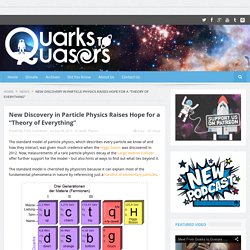
Now, measurements of a rare particle-physics decay at the Large Hadron Collider offer further support for the model – but also hints at ways to find out what lies beyond it. The standard model is cherished by physicists because it can explain most of the fundamental phenomena in nature by referencing just a handful of elementary particles. The elementary particles that according to the standard model makes up matter.
By HolgerFiedler nach Benutzer:Murphee via Wikimedia Commons, CC BY-SA These particles include quarks (one of the components of an atom) and electron-like particles called leptons – along with their so-called antiparticles which are identical but have opposite charge. Scientists Report Teleportation of Physical Objects From One Location To Another. The concept of teleportation comes primarily from science fiction literature throughout human history, but things are changing.
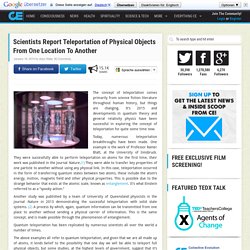
It’s 2015 and developments in quantum theory and general relativity physics have been successful in exploring the concept of teleportation for quite some time now. Today, numerous teleportation breakthroughs have been made. One example is the work of Professor Rainer Blatt, at the University of Innsbruck. They were successfully able to perform teleportation on atoms for the first time, their work was published in the journal Nature.(1) They were able to transfer key properties of one particle to another without using any physical link. In this case, teleportation occurred in the form of transferring quantum states between two atoms, these include the atom’s energy, motion, magnetic field and other physical properties. Quantum mechanics. QUANTUM PHYSICS.
History of Quantum mechanics. Fundamental components. Quantum field theory. Quantum mechanics equations. Interactions with other scientific theories. Philosophical implications. Examples. Articles. Ideas related to Quantum mechanics. Experiments.